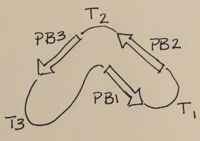Polygalacturonase
From Proteopedia
(Difference between revisions)
| Line 16: | Line 16: | ||
== Structural highlights == | == Structural highlights == | ||
| - | The tertiary fold of PGs varies in its composition of coils, approximating at 10 coils in a right-handed parallel beta helix domain along with loop regions that together form the substrate-binding cleft, which appears to have a tunnel-like shape. The active site of PGs is found between the looped regions of the protein. Located within the looped regions are two conserved aspartate residues that are predicted to participate in catalytic activity <ref name="crystal"/ | + | The tertiary fold of PGs varies in its composition of coils, approximating at 10 coils in a right-handed parallel beta helix domain along with loop regions that together form the substrate-binding cleft, which appears to have a tunnel-like shape. The active site of PGs is found between the looped regions of the protein. Located within the looped regions are two conserved aspartate residues that are predicted to participate in catalytic activity <ref name="crystal" />. |
MDY- a right-handed parallel beta helix is a tertiary fold. The secondary structure is the beta and the alpha structure. If you describe how the secondary structure folds in space, that becomes tertiary structure. The secondary structural elements of the core fold of the proteins are only beta structure, the beta strands form parallel beta sheets. There are three main parallel beta sheets, PG's often have a smaller parallel beta sheet of only three-four beta strands. Nomenclature on how the sheets and turns are labeled are described in Yoder et al <ref>PMID:8081738</ref>. | MDY- a right-handed parallel beta helix is a tertiary fold. The secondary structure is the beta and the alpha structure. If you describe how the secondary structure folds in space, that becomes tertiary structure. The secondary structural elements of the core fold of the proteins are only beta structure, the beta strands form parallel beta sheets. There are three main parallel beta sheets, PG's often have a smaller parallel beta sheet of only three-four beta strands. Nomenclature on how the sheets and turns are labeled are described in Yoder et al <ref>PMID:8081738</ref>. | ||
Revision as of 19:50, 7 January 2018
| |||||||||||
Proteopedia Page Contributors and Editors (what is this?)
Joel L. Sussman, Krishna Amin, Michal Harel, Marilyn Yoder, OCA, Jaime Prilusky


